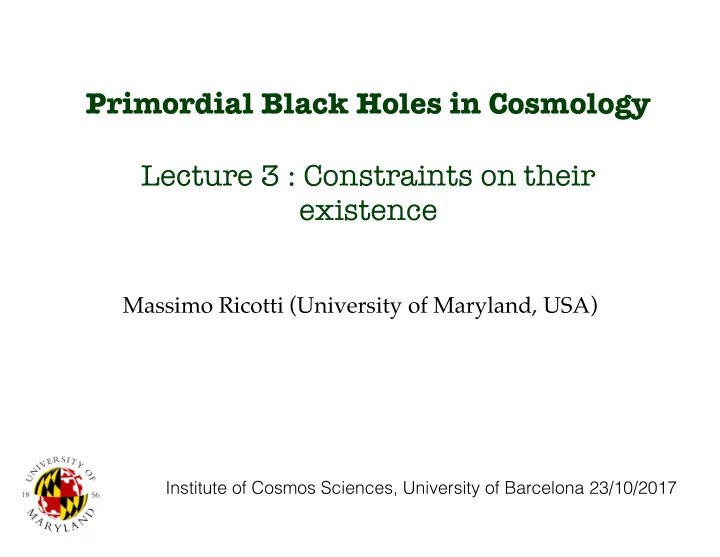

Primordial Black Holes in Cosmology Lecture 3 : Constraints on their existence Massimo Ricotti (University of Maryland, USA) Institute of Cosmos Sciences, University of Barcelona 23/10/2017
Astrophysical Constraints • Microlensing • Macho, EROS, etc • UCMHs: lensing, astrometry, DM annihilation • Dynamical constraints • Power spectrum • Dynamical heating (halo binaries and dwarfs) • Gravitational waves from binary PBHs • Capture • Primordial binaries • Effects on CMB, reionization and detection in X-ray, Radio (next lecture) Institute of Cosmos Sciences, University of Barcelona
WIMPS DM Institute of Cosmos Sciences, University of Barcelona
Constraints on evaporating PBHs Carr, Bernard J. Springer Proc.Phys. 170 (2016) 23-31 arXiv:1402.1437 [gr-qc] Institute of Cosmos Sciences, University of Barcelona
Constraints on non-evaporating PBHs PHYSICAL REVIEW D 94, 083504 (2016) Ref: Carr, Kühnel, Sandstad 2016 Institute of Cosmos Sciences, University of Barcelona
FIG. 3. Constraints on f ð M Þ for a variety of evaporation (magenta), dynamical (red), lensing (cyan), large-scale structure (green) and accretion (orange) effects associated with PBHs. The effects are extragalactic γ -rays from evaporation (EG) [11], femtolensing of γ -ray bursts (F) [187], white-dwarf explosions (WD) [188], neutron-star capture constraints (NS) [36], Kepler microlensing of stars (K) [189], MACHO/EROS/OGLE micro- lensing of stars [27] and quasar microlensing (broken line) [190] (ML), survival of a star cluster in Eridanus II (E) [191], wide binary disruption (WB) [37], dynamical friction on halo objects (DF) [33], millilensing of quasars (mLQ) [32], generation of large-scale structure through Poisson fluctuations (LSS) [14] and accretion effects (WMAP and FIRAS) [15]. Only the strongest constraint is usually included in each mass range, but the accretion limits are shown with broken lines since they are highly model dependent. Where a constraint depends on some extra parameter which is not well known, we use a typical value. Most constraints cut off at high M due to the incredulity limit. See the original references for more accurate forms of these constraints. Institute of Cosmos Sciences, University of Barcelona
Institute of Cosmos Sciences, University of Barcelona
Microlensing • Initial MACHO results: observed 17 events and claimed that these were consistent with compact objects of M ∼ 0.5M ⊙ contributing 20% of the halo mass (Alcock et al. 2000) • Later these lensing events revisited by EROS, OGLE, etc and attributed to self-lensing or clumping in the halo. • Limits shown in the figure are from null detections Institute of Cosmos Sciences, University of Barcelona
From Mack, Ostriker, Ricotti (2006) Refs: MACHO collaboration [ e.g. , Alcock et al. (1998, 2000, 2001); Hamadache et al. 2006]; EROS collaboration; Lacey & Ostriker 85; Moore 93; Carr 94; Afshordi, McDonald & Spergel Physics Coll. Virginia Tech, 02-08-2008 – p.10/37 Institute of Cosmos Sciences, University of Barcelona 03; Yoo et al. 04
Matter power spectrum at small scales N. Afshordi ,P. McDonald and D. N. Spergel (2003) Poisson statistics: P(k)=k n with n=0 sigma=M (n+3)/6= M 1/2 Institute of Cosmos Sciences, University of Barcelona
Ly-alpha forest, flux power spectrum (1D) Institute of Cosmos Sciences, University of Barcelona
Dynamical constraints • Unbinding of soft binaries in galactic halo • Disk heating/stability • Stability of tidal streams • Heating of stars in dwarfs (ultra-faint dwarfs) Institute of Cosmos Sciences, University of Barcelona
T. D. Brandt, Astrophys. J. 824, L31 (2016). Institute of Cosmos Sciences, University of Barcelona
T. D. Brandt, Astrophys. J. 824, L31 (2016). Institute of Cosmos Sciences, University of Barcelona
GW constraints • Primordial-binaries: (Nakamura et al.,1997, Sasaki et al. 2016) • Binary formation by capture in mini halos (Bird et al. 2016, Kovetz 2017) Institute of Cosmos Sciences, University of Barcelona
(Sasaki et al. 2016) Institute of Cosmos Sciences, University of Barcelona
(Kovetz 2017) Institute of Cosmos Sciences, University of Barcelona
Ali-Haimoud et al. 2017 � �� � u l micro-lensing t ������ ���� ��� � �� � r a - wide binaries f a i CMB anisotropies n t CMB anisotropies �� � d w a r f ����� s �� � ��� ( � ��� ) ���� ����� ��� �� potential limits ����� from LIGO O1 run � � �� �� ��� ��� ���� � � �� �� ��� ��� ���� � � ��� � ��� / � ⊙
Effects of broad mass spectrum of PBHs Ref: Carr, Kühnel, Sandstad 2016 Scenario B Scenario A 1.0 1.0 Kepler White 0.8 WB 0.8 dwarf Neutron star capture capture 0.6 Eridanus II 0.6 GRB f f femto EROS 0.4 0.4 lensing 0.2 0.2 0.0 0.0 1 5 10 50 100 500 1000 10 19 10 21 10 23 10 25 M g M M Scenario C Scenario D 1.0 1.0 GRB 0.8 0.8 extragalactic femtolensing Relics GRBs Removed by PBH Relics dominate 0.6 0.6 f f inflation at evaporation 0.4 0.4 0.2 0.2 0.0 0.0 10 5 10 15 10 16 10 17 10 18 10 7 0.1 1000 M g M g Institute of Cosmos Sciences, University of Barcelona
(Green 2016) FIG. 3. Constraints on the width, σ , of the DHF functional form, Eq. (10), as a function of the central mass Mc. Parameter values in the red hatched area in the bottom left produce Nexp ≥ 3 microlensing events in the EROS-2 survey and are excluded at 95% confidence. The blue hatched area in the top right is excluded by the heating of ultrafaint dwarfs. The constraint from the disruption of the star cluster in Eri II is tighter and excludes a large region of parameter space. Institute of Cosmos Sciences, University of Barcelona
Accretion constraints • Effects on the CMB anisotropies (Ricotti et al. 2007, Ali-Halımoud & Kamionkowski 2017, Horowitz 2016, Poulin et al. 2017, Bellomo et al. 2017, Bernal et al 2017) • Moving PBHs in galactic center (Gaggero et al. 2017) Institute of Cosmos Sciences, University of Barcelona
Moving PBHs in Galactic center (Gaggero et al. 2017) Institute of Cosmos Sciences, University of Barcelona
Institute of Cosmos Sciences, University of Barcelona
Recommend
More recommend